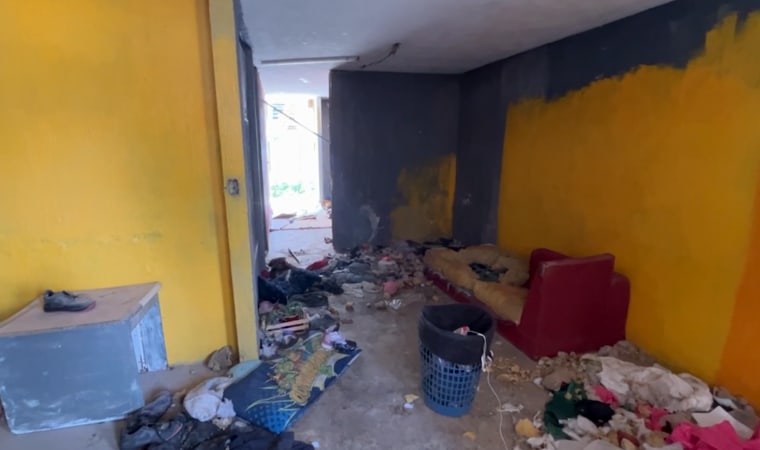-
Mets Trade Idea Replaces Griffin Canning With $15 Million Freddy Peralta - 11 mins ago
-
Paramount, President Trump reach $16 million settlement over “60 Minutes” lawsuit - 16 mins ago
-
Guardians vs. Cubs Highlights | MLB on FOX - 25 mins ago
-
Szijjártó: Leave Hungarians alone and let us live as we want - 31 mins ago
-
Eagles’ Saquon Barkley Sends Clear Message To Cowboys - 49 mins ago
-
Athletics vs. Rays Highlights | MLB on FOX - about 1 hour ago
-
NY Giants QBs Praised For Unique Leadership Approach - 2 hours ago
-
Sean ‘Diddy’ Combs jury deadlocked on key charge after deliberations - 2 hours ago
-
Astros vs. Rockies Highlights | MLB on FOX - 2 hours ago
-
Commanders WR Spotted With Trainer Amid Online Criticism - 2 hours ago
He escaped a ‘panic house’ in Mexico, where young drug users end up as hit men — or dead
The young man said he’s lived in fear ever since he developed an addiction to drugs and later fell prey to drug trafficking in Guanajuato, central Mexico. “Unfortunately, they’ve already killed my best friend and my relatives,” said the 19-year-old, whose name is being withheld since he’s afraid of reprisals.
“Drug addiction led me to a critical condition. I couldn’t find a way out, and I was scared,” he told Noticias Telemundo.
A year ago, he managed to escape from a panic house (also known as panicueva, or panic cave) commonly used by organized crime gangs in Mexico. Some of these buildings, located in Guanajuato and other states where drug use is rampant, also serve as recruitment bases for young people selected to become hit men and operatives for these criminal groups.
“It’s the place where you can go, buy your drugs, and get high right there,” said another 19-year-old who managed to escape a panic house and was interviewed by Noticias Telemundo on the condition that he remain anonymous for fear of retaliation.
“I entered a panic house and saw several women who had to prostitute themselves, and several of my friends got involved in selling drugs and ended up being killed,” said the young man. He said he spent five years living in one of the houses and eventually joined a local gang.
According to the latest report issued by the Mexican government, Guanajuato is the state with the highest number of homicides (980 from January to April). In February, the daily average reached 12.5. Last year, the Victimization and Security Perception Survey revealed that 87.5% of the population in Guanajuato considered public safety to be the most serious problem in the state.
“They’ve put a gun to my head, they’ve threatened me, they’ve told me I’m done, that’s it. But the most horrible thing I’ve seen is how they killed my best friend,” the young man said, referring to his experience in the shelters.
“I was required to do many things … they send us to train to use a firearm, all of that comes together and from there come the hit men, from there come the thieves, the hawks,” he said, referring to the murderers, thieves and drug traffickers.
‘They are recruiting more minors’
Guanajuato is grappling with gang clashes over criminal activities such as fuel trafficking, and is also the epicenter of a growing methamphetamine epidemic. According to data from the Federal Ministry of Health, the addiction rate to this drug in the state grew 449% over the past 20 years.
For David Miranda, a counselor at the Las Joyas de León Addiction Assistance Center, a civil association, the rise in methamphetamine use is creating a social crisis in the state.
“They’re recruiting more minors, ages 12 to 17,” Miranda said. “Within these ‘panic houses,’ they recruit many minors who are now hit men.”
Noticias Telemundo visited the Las Joyas neighborhood in the municipality of León, where, according to the state’s Security Secretariat, criminal groups have taken over a 380-unit housing complex.

“The situation in León right now is demanding and very serious,” Miranda said. “Inside those houses there are women, girls, minors, and you see drug trafficking, trafficking of women, trafficking of everything.”
Most panic houses are in working-class neighborhoods like Las Joyas. According to the state government, there could be up to 60,000 homes across Guanajuato currently being used for illegal drug use.
“In fact, you can see a panic house on any corner, anywhere. It’s very easy to find them. There are many abandoned houses,” one of the young men interviewed by Noticias Telemundo said.
‘I don’t want to be caught again’
According to state figures, at least 10 people have been murdered in panic houses in the last two years, and around 400 neighborhoods in the state are struggling with high crime rates.
“León is the number one city in terms of drug dealing,” said Juan Mauro González, Guanajuato’s secretary of security.
“Drug houses” aren’t unique to Mexico; similar trends exist in other countries, such as drug houses in the United States or drug dens in Spain. “While criminals may be attracted to abandoned houses, these are also spaces where potential victims and criminals tend to converge without surveillance. Our results support the idea that abandoned houses also generate crime,” said Lauren C. Porter, a professor at the University of Maryland who co-wrote a study on the issue.
“The most important thing to rehabilitate people is to change their mindset. They have to say they don’t want that anymore, that they no longer want to suffer or be in that world where they were humiliated, abused, and forced to do things. They should want a different life; we do the rest and we help them,” said Miranda, who said his addiction center has a capacity to serve 150 people.
Meanwhile, young people like the ones interviewed by Noticias Telemundo continue to struggle to avoid falling back into addiction and the dangers of the “haunted houses” that abound on some areas of Guanajuato.
“I’m scared. I don’t want them to catch me again and force me to do things,” said one of the men, who told Noticias Telemundo he wants to move to another neighborhood and have an honest job as a pizza maker, as he enjoys feeding people.
“My life is already very ruined, I was very humiliated,” he said. “It’s time to make a change.”
An earlier version of this story was first published in Noticias Telemundo.
Source link































